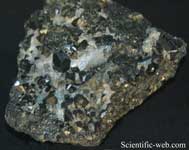| - Art Gallery - |
Magnetite is a ferrimagnetic mineral with chemical formula Fe3O4, one of several iron oxides and a member of the spinel group. The chemical IUPAC name is iron(II,III) oxide and the common chemical name ferrous-ferric oxide. The formula for magnetite may also be written as FeO·Fe2O3, which is one part wüstite (FeO) and one part hematite (Fe2O3). This refers to the different oxidation states of the iron in one structure, not a solid solution. The Curie temperature of magnetite is 858 K (585 °C; 1,085 °F). Properties Magnetite is the most magnetic of all the naturally occurring minerals on Earth.[4] Naturally magnetized pieces of magnetite, called lodestone, will attract small pieces of iron, and this was how ancient man first discovered the property of magnetism. Lodestone was used as an early form of magnetic compass. Magnetite typically carries the dominant magnetic signature in rocks, and so it has been a critical tool in paleomagnetism, a science important in discovering and understanding plate tectonics and as historic data for magnetohydrodynamics and other scientific fields. The relationships between magnetite and other iron-rich oxide minerals such as ilmenite, hematite, and ulvospinel have been much studied, as the complicated reactions between these minerals and oxygen influence how and when magnetite preserves records of the Earth's magnetic field. Magnetite has been very important in understanding the conditions under which rocks form and evolve. Magnetite reacts with oxygen to produce hematite, and the mineral pair forms a buffer that can control oxygen fugacity. Commonly igneous rocks contain grains of two solid solutions, one between magnetite and ulvospinel and the other between ilmenite and hematite. Compositions of the mineral pairs are used to calculate how oxidizing was the magma (i.e., the oxygen fugacity of the magma): a range of oxidizing conditions are found in magmas and the oxidation state helps to determine how the magmas might evolve by fractional crystallization. Small grains of magnetite occur in almost all igneous rocks and metamorphic rocks. Magnetite also occurs in many sedimentary rocks, including banded iron formations. In many igneous rocks, magnetite-rich and ilmenite-rich grains occur that precipitated together from magma. Magnetite also is produced from peridotites and dunites by serpentinization. Magnetite is a valuable source of iron ore. It dissolves slowly in hydrochloric acid. Distribution of deposits Huge deposits have been found in banded iron formations. These sedimentary rocks have been used to infer changes in the oxygen content of the atmosphere of the Earth. Large deposits of magnetite are also found in the Atacama region of Chile, Kiruna, Sweden, the Pilbara, Midwest and Northern Goldfields regions in Western Australia, and in the Adirondack region of New York in the United States. Deposits are also found in Norway, Germany, Italy, Switzerland, South Africa, India, Mexico, and in Oregon, New Jersey, Pennsylvania, North Carolina, Virginia, New Mexico, Utah, and Colorado in the United States. Recently, in June 2005, an exploration company, Cardero Resources, discovered a vast deposit of magnetite-bearing sand dunes in Peru. The dune field covers 250 square kilometers (100 sq mi), with the highest dune at over 2,000 meters (6,560 ft) above the desert floor. The sand contains 10% magnetite.[5] Biological occurrences Crystals of magnetite have been found in some bacteria (e.g., Magnetospirillum magnetotacticum) and in the brains of bees, of termites, fish, some birds (e.g., the pigeon) and humans.[6] These crystals are thought to be involved in magnetoreception, the ability to sense the polarity or the inclination of the Earth's magnetic field, and to be involved in navigation. Also, chitons have teeth made of magnetite on their radula making them unique among animals. This means they have an exceptionally abrasive tongue with which to scrape food from rocks. The study of biomagnetism began with the discoveries of Caltech paleoecologist Heinz Lowenstam in the 1960s. Preparation as a ferrofluid Magnetite also can be prepared by chemical co-precipitation, which consist in a mixture of a solution 0.1 M of FeCl3·6H2O and FeCl2·4H2O with mechanic agitation of about 2000 rpm. The molar ratio of FeCl3:FeCl2 can be 2:1; heating this solution at 70 °C, and immediately the rpm is elevated to 7500 rpm and adding quickly a solution of NH4OH (10 volume %), immediately a dark precipitate will be formed, which consist of nanoparticles of magnetite. Application as a sorbent Magnetite powder efficiently removes arsenic(III) and arsenic(V) from water, the efficiency of which increases ~200 times when the magnetite particle size decreases from 300 to 12 nm.[7] Arsenic-contaminated drinking water is a major problem around the world, which can be solved using magnetite as a sorbent. Industry Because of its stability at high temperatures, it is used for coating industrial water tube steam boilers. The magnetite layer is formed after a chemical treatment (e.g. by using hydrazine). Jewelry Magnetite is commonly used as the primary material in jewelry worn by adherents of the controversial[8] hypothesis of magnet therapy. When polished and made into jewelry magnetite has a dark, shiny finish with a smooth surface.
1. ^ http://www.handbookofmineralogy.com/pdfs/magnetite.pdf Handbook of Mineralogy
* Hurlbut, Cornelius S.; Klein, Cornelis (1985). Manual of Mineralogy (20th ed.). Wiley. ISBN 0471805807.
* Mineral galleries
Retrieved from "http://en.wikipedia.org/" |
|

